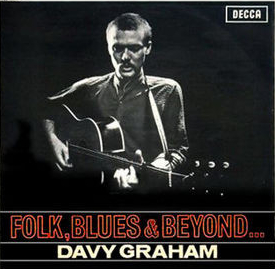Folk, Blues and Beyond
| Folk, Blues and Beyond | ||||
|---|---|---|---|---|
 |
||||
| Studio album by Davey Graham | ||||
| Released | January 1965 | |||
| Genre | Folk, folk baroque, Progressive folk, raga rock, blues, jazz | |||
| Length | 44:26 | |||
| Label | Topic | |||
| Producer | Ray Horricks | |||
| Davey Graham chronology | ||||
|
||||
| Professional ratings | |
|---|---|
| Review scores | |
| Source | Rating |
| Allmusic | |
Folk, Blues and Beyond is the second studio album by British musician Davey Graham, originally released in 1965.
It has been considered Graham's most groundbreaking and consistent work and a defining record of the 20th century. It has also been a primary influence on some of the most popular musicians in Britain ranging from Bert Jansch to Jimmy Page and Eric Clapton.
His first album, The Guitar Player, was almost exclusively jazz based. He was also known for his collaborations with folksinger Shirley Collins, which had established his name in the purist folk communities in Britain.
In his Allmusic review, critic Richie Unterberger stated "This was Graham's most groundbreaking and consistent album. More than his solo debut The Guitar Player (which was pretty jazzy) or his previous collaboration with folk singer Shirley Collins, Folk Roots, New Routes, this established his mixture of folk, jazz, blues, and Middle Eastern music, the use of a bassist and drummer also hinting at (though not quite reaching) folk-rock. "Leavin' Blues," "Skillet (Good'n'Greasy)," and "Moanin'" are all among his very best folk-blues-rock performances, while on "Maajun" he goes full-bore into Middle Eastern music on one of his most haunting and memorable pieces. Covers of traditional folk standards like "Black Is the Colour of My True Love's Hair" and "Seven Gypsies" combine with interpretations of compositions by Bob Dylan ("Don't Think Twice, It's Alright"), Willie Dixon ("My Babe"), Charles Mingus ("Better Git in Your Soul"), and Reverend Gary Davis ("Cocaine") for an eclecticism of repertoire that wasn't matched by many musicians of any sort in the mid-'60s. If there is one aspect of the recording to criticize, it is, as was usually the case with Graham, the thin, colorless vocals. The guitar playing is the main attraction, though; it's so stellar that it makes the less impressive singing easy to overlook. Ten of the 16 songs were included on the compilation Folk Blues and All Points in Between, but Graham fans should get this anyway, as the level of material and musicianship is pretty high throughout most of the disc."
...
Wikipedia
